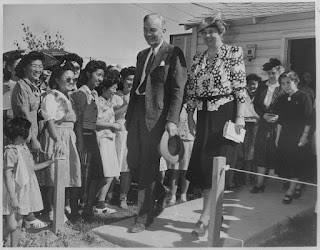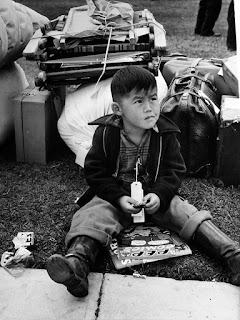A principios de la Segunda Guerra Mundial los japoneses,
incluso con ciudadanía norteamericana, fueron encerrados en campos de concentración en los Estados Unidos,
sospechados de traición, sabotaje y estar a favor de Japón. La opinión pública favorecía el encierro de los
descendientes de japoneses.
… la Comisión encontró poca evidencia de deslealtad
japonesa en ese momento y concluyó que el encarcelamiento había sido producto
del racismo…
La detención
(internment) de japoneses estadounidenses
en los Estados Unidos durante la Segunda Guerra Mundial fue la
reubicación forzada y el encarcelamiento en campos de concentración en el
interior del país de aproximadamente 120.000 personas de ascendencia japonesa,
la mayoría de los cuales vivían en la costa
del Pacífico. Sesenta y dos por ciento de los internos eran ciudadanos de los Estados Unidos. Estas acciones
fueron ordenadas por el presidente Franklin
D. Roosevelt poco después del ataque del Japón imperial a Pearl Harbor.
 |
| Eleanor Roosevelt, Gila River, 1943 |
Se considera que la detención resultó
más del racismo que de cualquier riesgo de seguridad que plantearan los
japoneses estadounidenses. El coronel Karl Bendetsen, el arquitecto detrás del programa, llegó a decir
que cualquiera con "una gota de sangre japonesa" calificaba.
 |
| Tagged for evacuation, Salinas, 1942 |
En 1980,
bajo la creciente presión de la Japanese
American Citizens League y otras organizaciones el presidente Jimmy Carter abrió una investigación
para determinar si la decisión de poner japoneses estadounidenses en campos de
concentración había sido justificada. Nombró a la Commission on Wartime
Relocation and Internment of Civilians (CWRIC) para investigar los campos. El
informe de la Comisión, titulado Personal Justice Denied, encontró
poca evidencia de deslealtad japonesa en ese momento y concluyó que el encarcelamiento
había sido producto del racismo. Recomendó que el gobierno pague
reparaciones a los internos. En 1988,
el presidente Ronald Reagan promulgó
la Ley de Libertades Civiles de 1988,
que se disculpó por el internamiento en nombre del gobierno de los EE. UU. y autorizó un pago de $ 20.000
(equivalente a $ 42.000 en 2018) a cada sobreviviente del campamento. La
legislación admitió que las acciones del gobierno se basaron en
"prejuicios raciales, histeria de guerra y un fracaso del liderazgo
político".
Newspaper
editorials
A Los Angeles Times editorial dated
February 19, 1942, stated that:
Since Dec. 7 there has existed an obvious menace to the safety of this
region in the presence of potential saboteurs and fifth columnists close to oil
refineries and storage tanks, airplane factories, Army posts, Navy facilities,
ports and communications systems…
A Washington Post editorial dated February
22, 1942, stated that:
There is but one way in which to regard the
Presidential order empowering the Army to establish "military areas"
from which citizens or aliens may be excluded. That is to accept the order as a
necessary accompaniment of total defense…
A Los Angeles Times editorial dated
February 28, 1942, stated that:
As to a considerable number of Japanese, no
matter where born, there is unfortunately no doubt whatever. They are for
Japan; they will aid Japan in every way possible by espionage, sabotage and
other activity; and they need to be restrained for the safety of California and
the United States…
Executive Order
9066, signed by President Franklin D.
Roosevelt on February 19, 1942,
set in motion the forced removal and imprisonment of all people of Japanese
ancestry (citizens and non-citizens alike) living on or near the West Coast.
—On March 30,
that morning, at 9 o´clock, soldiers came.
—Tears roll down
my eyes to think that I´m leaving.
—It was hard to
explain to someone what it was like in the camp. We never tell them the truth.
It was horrible.
The real story
of this exhibition is the incarceration of the Japanese- Americans following
the bombing of Pearl Harbor… Pearl Harbor allowed the government… removed the
Japanese- Americans from the West Coast… they lost their homes, they lost their
jobs, they lost their farms… and they were moved to the interior.
—One of the
strengths of the exhibition is what it show us… it makes a real effort to show
their experiences in a real way… there are video interviews with people who
were incarcerated. I think it´s an emotional exhibition…
—The
constitution promises liberty and justice. The Bill of Rights protects us. We
in no way have been protected by…
—Japanese-Americans
were people just like any of the viewers… many of them have lived in the
country for over 50 years. Children that you see in the pictures were born and
raised in the United States and regardless of that they were summarily deprived
of them…
—It happened to
us and it can happen to you…
Artículos
relacionados
… A lo largo de su carrera, desafió los prejuicios
raciales que encontró dentro y fuera de la pista y se convirtió en un modelo
para otros atletas… Major
Taylor
… John F. Kennedy pronunció su famoso discurso anunciando
que comenzaría a presionar por la legislación de derechos civiles… La
marcha de Washington
… la depresión fue diferente para los granjeros.
Nosotros teníamos de todo Sobrevivientes
de la depresión
No comments:
Post a Comment